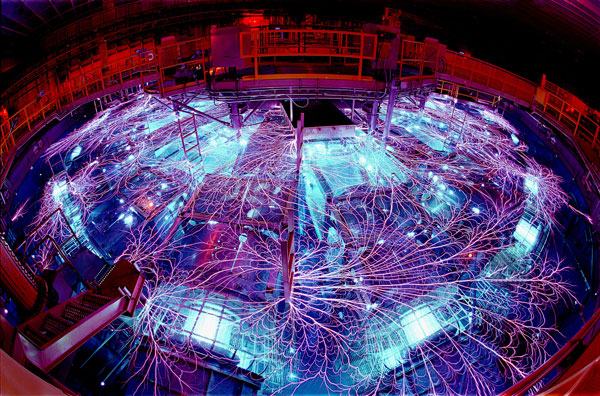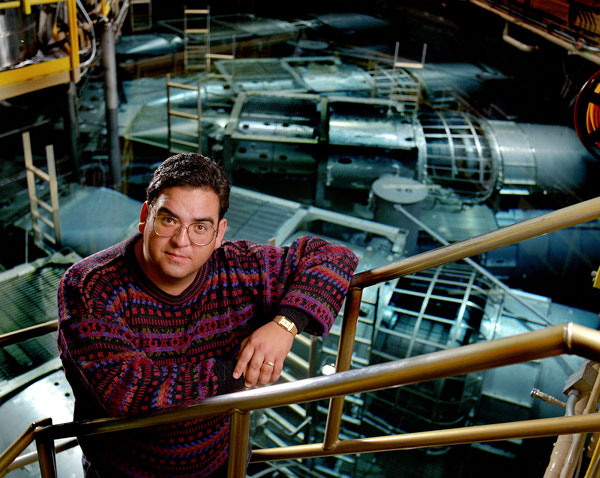See below: “What happens when Z fires“
For Sandians, President Truman’s letter to AT&T on May 13, 1949, is their sacred text.
If they have a totem animal, it’s that one-eyed, big-shouldered bird that watches over everything they do.
And they surround themselves with hallowed images, too: micrographs of molecules making seemingly impossible moves; pictures of amazing devices that would make Rube Goldberg gasp; incredibly detailed charts showing the progress of complex, multifaceted missions; even team portraits from days gone by.
But only one image has attained iconic status. Only one illustrates Sandia on walls and websites everywhere — Randy Montoya’s startling photograph capturing the Z machine at work on a warm spring afternoon in May 1998. Stand and stare at the immense blow-up of his picture at the entrance to Z, and soon the viewer senses something akin to a projection of the brain’s neuronal activity on the back of the eyelids, an impossibly energetic, improbably all-encompassing light show.

It’s an unusual photo. It shows the release for just 100 nanoseconds of roughly 200 trillion watts of x-ray energy, many times all the electrical power generated in the world at any given moment.
More mundanely, it’s a partial view of roughly one-third of Z’s surface as the machine actually fires, with the hood up.
Often referred to by its nickname, Arcs and Sparks, the image is ubiquitous, gracing the covers of physics textbooks, used and misused to illustrate countless technical documents and websites. It was even named one of National Geographic’s 1,000 Greatest Images in 2004.
Randy had photographed the Z machine many times, but a discussion with former Sandia VP Don Cook inspired him to try something else.
“I told Don, I want to put a lens right down inside the target,” he says. “I wanted to get away from showing a pattern and instead get a shot of lightning right up in your face. My management told me it was impossible.
“This weird thing called the internet was just taking off and I must admit I was inspired, seeing all these great photographers trying to make science more personal, trying to get people interested in the nuts and bolts of how people do science,” he recalls.
“This was an actual experiment,” he emphasizes. “Absolutely anything could happen.”
Z was in its infancy then. But the pace of work was no less heated than today, with experiments, or shots, sometimes happening twice a day.
“The most important fact about being a photographer at Sandia is that people almost always become excited about showing off their work. They are just so eager to help.”
Randy knew he couldn’t use one of the Labs’ new, fancy electronic cameras. The X-ray pulses from the Z machine would kill anything electronic. That was OK. Randy’s an old-school photographer.

“I went down to talk to Art at Camera and Darkroom and I told him, ‘I want to rent a camera, preferably a broken camera’,” he recalls. The shopkeeper gave him a beat-up Nikon F, “a nice old camera. It shot color negative film and that gave me more latitude.”
To trigger the second-hand camera, Randy scavenged 86 feet of surgical tubing — used to trigger leaf shutters on 4-by-5 cameras. Technicians helped him connect the tubing to a small air compressor so he could flip a switch to trip the shutter open for an exposure of approximately five seconds. He figured that was long enough to capture the light, since Z only fires for roughly about 100 billionths of a second.
Randy walked all around the huge machine with the crew until they discovered a spot where they could safely remove part of a walkway and mount the camera onto one of the diagnostic pipes, aiming into the target area, the heart of the beast.
“I just clamped it on the pole and hoped it was pointing at something that would show up on the negative.
“You know, there’s a fair amount of guessing to this. I used a small level after I’d clamped it and ran a roll of badly exposed film through there. There really wasn’t much to adjust or fine-tune.
“I had no idea what would happen. It’s a working facility,” Randy says. “You lash everything down the best you can, but everything’s banging and crashing.”
Randy waited outside the chamber with the technicians, all of them focused on the loudspeakers — “10 seconds, nine, eight …” — waiting for the moment when banks of generators would fire to generate 16 million amps, creating a fireball that for an instant would burn at more than 2 million degrees.
“As they were going through their countdown, we were pretty confident the camera would work,” he recalls. “We just didn’t know if we’d get anything.”
The normal target retrieval, safety checks and extensive clean-up work kept the Z crew busy late into the evening.
In the morning, Randy drove over to Z to retrieve the camera, with no idea whether he’d captured anything at all.
“I went back the next day and it was gone. My heart sank.”
The crew had carefully removed all of his equipment and put it in a box. When he developed the film, there it was.
“The fact of the star is in the burned-out hunk of charcoal spinning in deep space, but the truth of the star is in the stream of photons pulsating through the vacuum at light speed, slamming at light speed into the atoms of my retina, electrifying the optic nerve . . .”
“The Gardening of Thomas D.” by Rinde Eckert
One important fact that few non-engineers know about “Arcs and Sparks” is that — like an Avedon photo — it depicts the machine exactly as it was at the moment the shutter snapped, warts and all.
“All that lightning on the top is simply inefficiencies of the machine, because Z is designed to put all the electrical energy into the target,” he explains. “It’s kind of like a carburetor that isn’t mixing the fuel efficiently so you get a big exhaust plume out of the muffler. In a way, I was capturing the backwash from the experiment because of those inefficiencies. Those were early days, and Z is far more efficient now.”
It’s a cliché voiced by artists all the time, but the photo, viewed by millions over the past 20 years, truly was a team effort.
“Anyone who has photographed PBFA-1, PBFA-2, Hermes — all the big machines — whether it was me or National Geographic, we’ve all plagiarized from the work of the technicians” who had shot it before, he says. “Even the equipment I used to trigger the camera was playing off ideas from the first technicians who tried to capture the image.”
People ask Randy how many tries it took him to get the shot. “One,” he tells them, and when photographers inevitably ask, he explains why it could never happen again because of all the equipment installed later. The surface is plated over to bear the weight of additional test instruments.
“Every time I go into a place like Z and do something, I’m interrupting people’s work, so I try to work quickly,” he says. Surveying the scene and the lighting, gauging the people and how they feel about their work and a plethora of other intangibles guide him.
“People know that what I do, I do it because I’m trying to help the Laboratories,” he says.
What happens when Z fires
The Z machine uses electricity to charge large capacitors — structures designed to store an electric charge and release it almost instantaneously. These capacitors discharge to produce radiation and high magnetic pressures, which are used to study everything from nuclear weapons to planetary formation to fusion energy. When Z fires, powerful electrical pulses strike a target made of hundreds of tungsten wires. It’s about the size of a spool of thread. The flow of energy through the wires dissolves them into plasma and creates a strong magnetic field that forces the exploded particles inward. The speed at which the particles move is equivalent to traveling from Los Angeles to New York — about 3,000 miles — in slightly less than one second. The particles then collide with one another along the z axis (hence the name Z machine), and the collisions produce intense radiation (2 million joules of X-ray energy) that heats the walls of the target to approximately 1.8 million degrees Celsius.
Source: Science: Z Research